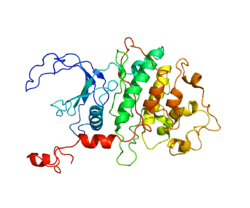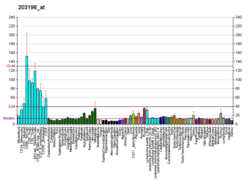Cyclin-dependent kinase 9
Cyclin-dependent kinase 9 or CDK9 is a cyclin-dependent kinase associated with P-TEFb.
Function
The protein encoded by this gene is a member of the cyclin-dependent kinase (CDK) family. CDK family members are highly similar to the gene products of S. cerevisiae cdc28, and S. pombe cdc2, and known as important cell cycle regulators. This kinase was found to be a component of the multiprotein complex TAK/P-TEFb, which is an elongation factor for RNA polymerase II-directed transcription and functions by phosphorylating the C-terminal domain of the largest subunit of RNA polymerase II. This protein forms a complex with and is regulated by its regulatory subunit cyclin T or cyclin K. HIV-1 Tat protein was found to interact with this protein and cyclin T, which suggested a possible involvement of this protein in AIDS.[5]
CDK9 is also known to associate with other proteins such as TRAF2, and be involved in differentiation of skeletal muscle.[6]
Interactions
CDK9 has been shown to interact with:
References
- GRCh38: Ensembl release 89: ENSG00000136807 - Ensembl, May 2017
- GRCm38: Ensembl release 89: ENSMUSG00000009555 - Ensembl, May 2017
- "Human PubMed Reference:". National Center for Biotechnology Information, U.S. National Library of Medicine.
- "Mouse PubMed Reference:". National Center for Biotechnology Information, U.S. National Library of Medicine.
- "Entrez Gene: CDK9 cyclin-dependent kinase 9 (CDC2-related kinase)".
- MacLachlan TK, Sang N, De Luca A, Puri PL, Levrero M, Giordano A (1998). "Binding of CDK9 to TRAF2". J. Cell. Biochem. 71 (4): 467–78. doi:10.1002/(SICI)1097-4644(19981215)71:4<467::AID-JCB2>3.0.CO;2-G. PMID 9827693.
- Lee DK, Duan HO, Chang C (March 2001). "Androgen receptor interacts with the positive elongation factor P-TEFb and enhances the efficiency of transcriptional elongation". J. Biol. Chem. 276 (13): 9978–84. doi:10.1074/jbc.M002285200. PMID 11266437.
- Kiernan RE, Emiliani S, Nakayama K, Castro A, Labbé JC, Lorca T, Nakayama Ki K, Benkirane M (December 2001). "Interaction between cyclin T1 and SCF(SKP2) targets CDK9 for ubiquitination and degradation by the proteasome". Mol. Cell. Biol. 21 (23): 7956–70. doi:10.1128/MCB.21.23.7956-7970.2001. PMC 99964. PMID 11689688.
- Fu TJ, Peng J, Lee G, Price DH, Flores O (December 1999). "Cyclin K functions as a CDK9 regulatory subunit and participates in RNA polymerase II transcription". J. Biol. Chem. 274 (49): 34527–30. doi:10.1074/jbc.274.49.34527. PMID 10574912.
- Peng J, Zhu Y, Milton JT, Price DH (March 1998). "Identification of multiple cyclin subunits of human P-TEFb". Genes Dev. 12 (5): 755–62. doi:10.1101/gad.12.5.755. PMC 316581. PMID 9499409.
- Cabart P, Chew HK, Murphy S (July 2004). "BRCA1 cooperates with NUFIP and P-TEFb to activate transcription by RNA polymerase II". Oncogene. 23 (31): 5316–29. doi:10.1038/sj.onc.1207684. PMID 15107825.
- Young TM, Wang Q, Pe'ery T, Mathews MB (September 2003). "The human I-mfa domain-containing protein, HIC, interacts with cyclin T1 and modulates P-TEFb-dependent transcription". Mol. Cell. Biol. 23 (18): 6373–84. doi:10.1128/MCB.23.18.6373-6384.2003. PMC 193714. PMID 12944466.
- Michels AA, Nguyen VT, Fraldi A, Labas V, Edwards M, Bonnet F, Lania L, Bensaude O (July 2003). "MAQ1 and 7SK RNA interact with CDK9/cyclin T complexes in a transcription-dependent manner". Mol. Cell. Biol. 23 (14): 4859–69. doi:10.1128/MCB.23.14.4859-4869.2003. PMC 162212. PMID 12832472.
- Hoque M, Young TM, Lee CG, Serrero G, Mathews MB, Pe'ery T (March 2003). "The growth factor granulin interacts with cyclin T1 and modulates P-TEFb-dependent transcription". Mol. Cell. Biol. 23 (5): 1688–702. doi:10.1128/MCB.23.5.1688-1702.2003. PMC 151712. PMID 12588988.
- De Falco G, Bagella L, Claudio PP, De Luca A, Fu Y, Calabretta B, Sala A, Giordano A (January 2000). "Physical interaction between CDK9 and B-Myb results in suppression of B-Myb gene autoregulation". Oncogene. 19 (3): 373–9. doi:10.1038/sj.onc.1203305. PMID 10656684.
- Garber ME, Mayall TP, Suess EM, Meisenhelder J, Thompson NE, Jones KA (September 2000). "CDK9 autophosphorylation regulates high-affinity binding of the human immunodeficiency virus type 1 tat-P-TEFb complex to TAR RNA". Mol. Cell. Biol. 20 (18): 6958–69. doi:10.1128/MCB.20.18.6958-6969.2000. PMC 88771. PMID 10958691.
- Amini S, Clavo A, Nadraga Y, Giordano A, Khalili K, Sawaya BE (August 2002). "Interplay between cdk9 and NF-kappaB factors determines the level of HIV-1 gene transcription in astrocytic cells". Oncogene. 21 (37): 5797–803. doi:10.1038/sj.onc.1205754. PMID 12173051.
- Simone C, Bagella L, Bellan C, Giordano A (June 2002). "Physical interaction between pRb and cdk9/cyclinT2 complex". Oncogene. 21 (26): 4158–65. doi:10.1038/sj.onc.1205511. PMID 12037672.
Further reading
- Jeang KT (1998). "Tat, Tat-associated kinase, and transcription". J. Biomed. Sci. 5 (1): 24–7. doi:10.1007/BF02253352. PMID 9570510.
- Yankulov K, Bentley D (1998). "Transcriptional control: Tat cofactors and transcriptional elongation". Curr. Biol. 8 (13): R447–9. doi:10.1016/S0960-9822(98)70289-1. PMID 9651670.
- Romano G, Kasten M, De Falco G, et al. (2000). "Regulatory functions of Cdk9 and of cyclin T1 in HIV tat transactivation pathway gene expression". J. Cell. Biochem. 75 (3): 357–68. doi:10.1002/(SICI)1097-4644(19991201)75:3<357::AID-JCB1>3.0.CO;2-K. PMID 10536359.
- Marcello A, Zoppé M, Giacca M (2002). "Multiple modes of transcriptional regulation by the HIV-1 Tat transactivator". IUBMB Life. 51 (3): 175–81. doi:10.1080/152165401753544241. PMID 11547919.
- Huigen MC, Kamp W, Nottet HS (2004). "Multiple effects of HIV-1 trans-activator protein on the pathogenesis of HIV-1 infection". Eur. J. Clin. Invest. 34 (1): 57–66. doi:10.1111/j.1365-2362.2004.01282.x. PMID 14984439.
- Rice AP, Herrmann CH (2004). "Regulation of TAK/P-TEFb in CD4+ T lymphocytes and macrophages". Curr. HIV Res. 1 (4): 395–404. doi:10.2174/1570162033485159. PMID 15049426.
- Minghetti L, Visentin S, Patrizio M, et al. (2004). "Multiple actions of the human immunodeficiency virus type-1 Tat protein on microglial cell functions". Neurochem. Res. 29 (5): 965–78. doi:10.1023/B:NERE.0000021241.90133.89. PMID 15139295.
- Liou LY, Herrmann CH, Rice AP (2005). "HIV-1 infection and regulation of Tat function in macrophages". Int. J. Biochem. Cell Biol. 36 (9): 1767–75. doi:10.1016/j.biocel.2004.02.018. PMID 15183343.
- Pugliese A, Vidotto V, Beltramo T, et al. (2005). "A review of HIV-1 Tat protein biological effects". Cell Biochem. Funct. 23 (4): 223–7. doi:10.1002/cbf.1147. PMID 15473004.
- Bannwarth S, Gatignol A (2005). "HIV-1 TAR RNA: the target of molecular interactions between the virus and its host". Curr. HIV Res. 3 (1): 61–71. doi:10.2174/1570162052772924. PMID 15638724.
- Gibellini D, Vitone F, Schiavone P, Re MC (2005). "HIV-1 tat protein and cell proliferation and survival: a brief review". New Microbiol. 28 (2): 95–109. PMID 16035254.
- Peruzzi F (2006). "The multiple functions of HIV-1 Tat: proliferation versus apoptosis". Front. Biosci. 11: 708–17. doi:10.2741/1829. PMID 16146763.
External links
- Cyclin-Dependent+Kinase+9 at the US National Library of Medicine Medical Subject Headings (MeSH)
- Drosophila Cyclin dependent kinase 9 - The Interactive Fly
- CDK9 human gene location in the UCSC Genome Browser.
- CDK9 human gene details in the UCSC Genome Browser.





